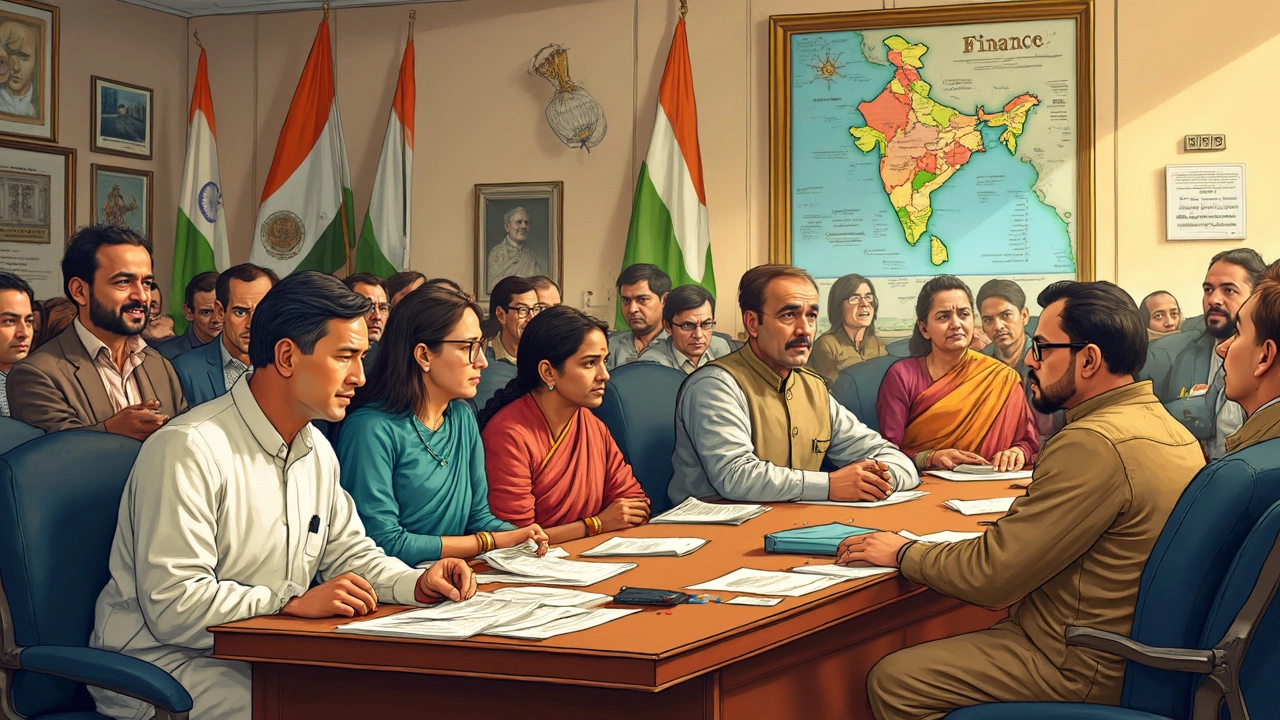Ever wondered who's pulling the strings behind India's government money? It's like a giant jigsaw puzzle with different players each holding a vital piece. If you're curious about how taxpayer money is managed—you're in the right place!
First things first, the Ministry of Finance is the big boss when it comes to managing the country’s purse strings. They're the ones in charge of preparing the Union Budget, setting financial regulations, and making sure all those rupees are used wisely. But that's just the tip of the iceberg.
On another level, there are other key players like the Planning Commission (or Niti Aayog today). These folks focus on strategic allocation and planning, making sure funds reach the places they're meant to help. It's a complex dance of figures and forecasts.
- Understanding the Financial Hierarchy
- The Role of the Ministry of Finance
- Budget Allocation and Implementation
- Impact of Government Schemes
- Checks and Balances in Financial Management
Understanding the Financial Hierarchy
When it comes to controlling government money in India, it's all about understanding the pecking order. Think of it like a giant corporation with various departments and managers, each tasked with a specific role in budgeting and expenditure. The hierarchy ensures that funds are managed efficiently and reach where they're needed the most.
At the top of this pyramid sits the Ministry of Finance. They're the masterminds behind framing financial policies, preparing the annual budget, and deciding on economic priorities. It's no small feat! The Union Budget, which they craft each year, outlines how much money will be spent on defense, infrastructure, welfare, and more.
But it's not just the finance guys running the show. We've got the Reserve Bank of India (RBI) acting as the country's central bank, keeping an eye on monetary policy and financial stability. Every decision they make impacts how effectively the government can implement its financial strategies.
Then, let's not forget about state governments and local bodies. They play a crucial role in implementing government schemes and ensuring that funds trickle down to every nook and corner of the country. The schemes sometimes come with strings attached, which provide a framework for spending as per central guidelines.
- Central Government: Headed by the Ministry of Finance, responsible for national policies and budget allocation.
- State Governments: They receive a portion of central funds and manage state-specific projects and expenses.
- Local Bodies: These include panchayats and municipalities handling district and village-level spending.
Together, these entities create a well-oiled machine to handle government funds, albeit one that occasionally needs maintenance to prevent leaks and ensure transparency. Each player has to answer to another, creating a system of checks and balances to prevent misuse and ensure accountable governance.
The Role of the Ministry of Finance
The Ministry of Finance is like the central nervous system when it comes to managing India’s vast financial ecosystem. It's not just about keeping an eye on the funds but steering the financial policies that shape the entire nation.
At the heart of their duties, preparing the Union Budget is a big deal. Every year, they pull together this financial blueprint, laying out how money will stream in and gush out. This includes projections for revenue and expenses, covering everything from defense to health to infrastructure projects.
But their job doesn't stop at budgeting. The Ministry also sets fiscal policies that determine everything from tax rates to government borrowing. They strive to create a balance between stimulating economic growth and keeping inflation in check.
Here’s an interesting bit: The Ministry oversees the GST Council, a body that sets crucial tax rates under the Goods and Services Tax regime. This impacts how money flows across states and delivers a unified monetary system across the country.
- Budget Formulation: Crafts the blueprint of government spending and revenue collection.
- Fiscal Policies: Manages taxes and borrowing to boost growth and stabilize the economy.
- GST Council Oversight: Ensures uniform tax implementation across India.
All these responsibilities mean the Ministry of Finance not only moves the wheel but keeps an active vigil on the country's financial health. Their decisions ripple through every sector, impacting everyday life in both subtle and profound ways.

Budget Allocation and Implementation
Alright, let’s talk about how the Indian government splits and spends its cash stash. The process of budget allocation kicks off with the Union Budget, which lays out the government's revenue and expenditure plans for the fiscal year. It's presented by the Finance Minister and gives a sneak peek into how taxpayer money will be utilized.
The budget allocation involves a detailed and exhaustive process. Various government departments propose their financial needs, which are then scrutinized by the Finance Ministry. Priority is often given to crucial areas like healthcare, education, and infrastructure development.
Once the budget is approved, the implementation phase swings into action. Each ministry or department receives its share of the financial pie, and then it's their job to ensure the money is used effectively. To keep things in check, there are auditing bodies like the Comptroller and Auditor General of India, which make sure funds aren't just slipping through the cracks.
Funds are disbursed through a mix of central and state schemes, catering to the diverse needs of the country. This ensures money reaches local levels where it can make a real difference.
To give you some perspective, here’s a quick overview table of the 2024 budget allocations:
| Sector | Budget Allocation (INR Crores) | % of Total Budget |
|---|---|---|
| Healthcare | 86,200 | 2.3% |
| Education | 99,300 | 2.7% |
| Infrastructure | 2,09,000 | 5.6% |
The above allocations highlight the government's focus areas, reflecting priorities in national development and public welfare.
Impact of Government Schemes
India has a bunch of government schemes aimed at boosting various sectors like agriculture, education, and healthcare. These schemes are not just buzzwords; they play a crucial role in how financial resources flow through the country. When designed and implemented well, they can significantly improve living standards and economic conditions.
Take the Pradhan Mantri Awas Yojana (PMAY) for instance. The aim here is to provide affordable housing to everyone in India by 2022. It's an ambitious target, but with solid planning and funding, many families are already seeing the benefits.
Then there's the Jan Dhan Yojana. This one's about making sure every household in India has a bank account. It’s pretty big when you think about how this system allows people, especially from rural areas, to finally access banking facilities and save money securely.
Of course, the impact isn't without its hassles. Sometimes funds don't reach their intended destination or projects face delays. But over the years, the focus has been on improving transparency and efficiency. Technology plays a big role here, with the government investing in digital platforms to streamline processes and track progress.
To give you an idea of scale, here's a quick lookup on some funding numbers for these schemes:
| Scheme | Allocated Funds (in Crores) |
|---|---|
| Pradhan Mantri Awas Yojana (Urban and Rural) | 27,500 |
| Jan Dhan Yojana | 850 |
So, government initiatives do make a difference, but their success boils down to execution and accountability. While some areas see significant improvement, others still lag behind, showing there's always room for better management and implementation.

Checks and Balances in Financial Management
In India, managing government money isn't just about spending it wisely—it's also about keeping things transparent and accountable. This is where the checks and balances come in, ensuring public funds are used appropriately.
The Comptroller and Auditor General of India (CAG) is pivotal in this process. Tasked with auditing government expenditures and ensuring the money goes where it's supposed to, the CAG scrutinizes financial activities closely. Their reports are essential for identifying irregularities and enforcing accountability.
Another key player is the Public Accounts Committee (PAC). This committee reviews the CAG's reports and makes sure the government takes corrective actions. Essentially, they're the watchdogs that ensure effective implementation of government schemes.
Moreover, transparency initiatives like the Public Financial Management System (PFMS) have made tracking government spending clearer. This online tool helps monitor real-time expenditure, making the flow of funds easier to understand and track. You can see how a scheme's funds are progressing right at your fingertips!
Let's not forget the role of local bodies, which ensure funds are appropriately utilized at the ground level. They've got the community insight needed to allocate resources effectively where they matter most.
Here's a simple rundown of typical checks:
- Auditing: Conducted by the CAG to ensure proper use of funds.
- Committees: Like the PAC, for reviewing reports and suggesting improvements.
- Transparency Tools: Such as PFMS for tracking expenditures.
- Local Oversight: Involvement of local bodies in managing and utilizing funds.
Financial control isn't just a bureaucracy maze; it's a detailed system meant to protect and serve the public's interest. So, while it can look complex from the outside, all these steps are in place to safeguard every rupee.

